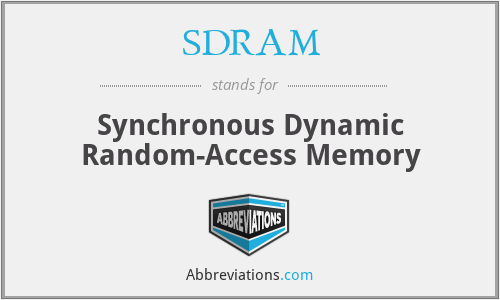What does SDRAM mean in Hardware?
This page is about the meanings of the acronym/abbreviation/shorthand SDRAM in the Computing field in general and in the Hardware terminology in particular.
Submitted by wikidude on September 12, 2019
Translation
Find a translation for Synchronous Dynamic Random-Access Memory in other languages:
Select another language:
- - Select -
- 简体中文 (Chinese - Simplified)
- 繁體中文 (Chinese - Traditional)
- Español (Spanish)
- Esperanto (Esperanto)
- 日本語 (Japanese)
- Português (Portuguese)
- Deutsch (German)
- العربية (Arabic)
- Français (French)
- Русский (Russian)
- ಕನ್ನಡ (Kannada)
- 한국어 (Korean)
- עברית (Hebrew)
- Gaeilge (Irish)
- Українська (Ukrainian)
- اردو (Urdu)
- Magyar (Hungarian)
- मानक हिन्दी (Hindi)
- Indonesia (Indonesian)
- Italiano (Italian)
- தமிழ் (Tamil)
- Türkçe (Turkish)
- తెలుగు (Telugu)
- ภาษาไทย (Thai)
- Tiếng Việt (Vietnamese)
- Čeština (Czech)
- Polski (Polish)
- Bahasa Indonesia (Indonesian)
- Românește (Romanian)
- Nederlands (Dutch)
- Ελληνικά (Greek)
- Latinum (Latin)
- Svenska (Swedish)
- Dansk (Danish)
- Suomi (Finnish)
- فارسی (Persian)
- ייִדיש (Yiddish)
- հայերեն (Armenian)
- Norsk (Norwegian)
- English (English)
Definition
What does SDRAM mean?
- Synchronous dynamic random-access memory
- Synchronous dynamic random-access memory (synchronous dynamic RAM or SDRAM) is any DRAM where the operation of its external pin interface is coordinated by an externally supplied clock signal. DRAM integrated circuits (ICs) produced from the early 1970s to early 1990s used an asynchronous interface, in which input control signals have a direct effect on internal functions only delayed by the trip across its semiconductor pathways. SDRAM has a synchronous interface, whereby changes on control inputs are recognised after a rising edge of its clock input. In SDRAM families standardized by JEDEC, the clock signal controls the stepping of an internal finite-state machine that responds to incoming commands. These commands can be pipelined to improve performance, with previously started operations completing while new commands are received. The memory is divided into several equally sized but independent sections called banks, allowing the device to operate on a memory access command in each bank simultaneously and speed up access in an interleaved fashion. This allows SDRAMs to achieve greater concurrency and higher data transfer rates than asynchronous DRAMs could. Pipelining means that the chip can accept a new command before it has finished processing the previous one. For a pipelined write, the write command can be immediately followed by another command without waiting for the data to be written into the memory array. For a pipelined read, the requested data appears a fixed number of clock cycles (latency) after the read command, during which additional commands can be sent.
Popularity rank by frequency of use
How popular is SDRAM among other acronyms?
SDRAM#1#1472#39933
Embed
Citation
Use the citation below to add this abbreviation to your bibliography:
Style:MLAChicagoAPA
"SDRAM." Abbreviations.com. STANDS4 LLC, 2024. Web. 28 Apr. 2024. <https://www.abbreviations.com/term/2138488>.



Discuss this SDRAM abbreviation with the community:
Report Comment
We're doing our best to make sure our content is useful, accurate and safe.
If by any chance you spot an inappropriate comment while navigating through our website please use this form to let us know, and we'll take care of it shortly.
Attachment
You need to be logged in to favorite.
Log In